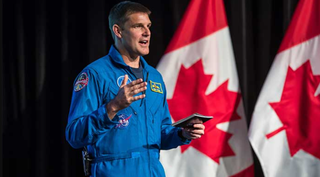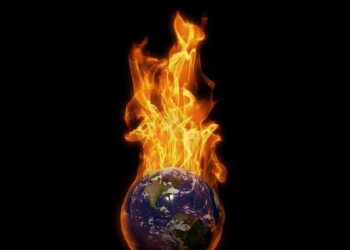Home
News
Spaceflight

Artemis 2 moon astronaut Jeremy Hansen, of the Canadian Space Agency, speaks in front of two Canadian flags.
(Image credit: Canadian Space Agency)
Canada’s Artemis 2 astronaut says his country is just getting started in lunar realms with his round-the-moon mission.
Jeremy Hansen was named Canada’s representative on Artemis 2 on April 3, and within days the experienced test pilot found himself exploring new worlds as a result: speaking with Stephen Colbert, walking the red carpet at Guardians of the Galaxy Vol. 3, participating in an Indigenous vision quest, visiting policy-makers in Canada and the U.S., and carrying the flag at the coronation of Charles III.
After this work to connect with numerous communities touched by space, the Artemis 2 crew officially began training on May 15, studying the control systems and computers of the Orion spacecraft and other technical matters.
In a few months, however the training timeline “gets a little fuzzy” as this will be the first moon crew in a half-century. The crew is awaiting direction, as well as development of simulators and procedures, from senior management. “For developmental missions, that’s to be expected,” Hansen told Space.com in an exclusive interview.
Related: Jeremy Hansen: Artemis 2 Canadian astronaut will fly around the moon
But there are a few things Hansen is sure about for himself and his three crewmates, all NASA astronauts: commander Reid Wiseman, mission specialist Christina Koch, and pilot Victor Glover.
There will be geology training to prepare for looking at moon craters, potentially with Canadian crater expert Gordon Osinski — with whom Hansen recently discovered a rare Earth crater on a previous expedition. There also will be continued conversations with Canadian and American policy-makers to chart out the path after Artemis 2, Hansen emphasized.
“Eventually, you’ll see us doing amazing science and deep space,” Hansen said. “You’ll see a Canadian walk on the moon someday, and eventually go to Mars, because we have that ability to to do it in a way that brings benefits to Canadians.”
The Canadian Space Agency (CSA) has suggested that Canada will have seats on Artemis 4 and 6, which are both planned moon-landing missions slated to run around the end of the decade.
CSA’s director of space exploration development, Martin Bergeron, disclosed those early stage discussions at the Canadian Lunar Workshop in late May, according to SpaceQ. (The first landing mission, Artemis 3, may be in 2025 or 2026.)
Related: Artemis 2’s Canadian astronaut got moon mission seat with ‘potato salad’

Canadian astronaut Jeremy Hansen (front) carries the flag of Canada during the coronation of Charles III on May 6. To Hansen’s right is Canada’s head of state (Governor General Mary Simon, the first Indigenous person to hold the role) and at center, Canadian prime minister Justin Trudeau. (Image credit: Stuart C. Wilson/Getty Images)
Hansen has been with the CSA since 2009 and has not yet been granted a seat, as Canada’s International Space Station (ISS) contribution of 2.3 percent generally allows for a mission only every half decade or so. (Canada’s Chris Hadfield flew in 2012-13 on a mission assigned before Hansen was qualified for space, and then fellow 2009 astronaut class member David Saint-Jacques flew in 2018-19.)
But Hansen is known in the space community for helming high-profile projects, such as managing the training schedules of the entire 2017 astronaut class, and playing a lead role in the creation four tricky spacewalks to repair the Alpha Magnetic Spectrometer aboard the ISS.
Many in Canada therefore pegged Hansen as the logical choice to launch on Artemis 2, but he said that was not a sure thing until he received a phone call from CSA president Lisa Campbell about two weeks before the April 3 announcement.
“I’ve known for a while that was sort of the intent, where we thought things would end up, so I wasn’t completely surprised,” Hansen said of the assignment. “But on the other hand, you just never know. It depends on when a mission actually is going to end up going, and there’s always that uncertainty. We don’t decide any further in advance than when we have to, because it just takes away options.”
Related: Canada’s Artemis 2 astronaut was named after a 14-year-wait for space
Canada received its seat due to its contribution of Canadarm3, a next generation robotic arm that will service NASA’s planned Gateway space station at the moon. Canada has paid for its seats through the Canadarm series since the dawn of the space shuttle program, and recently allocated even more space money for a mini-moon rover, a lunar utility vehicle and further moon research development.
The country, which has about 40 million people spread across one of the biggest land spaces in the world, uses its small space budget to make strategic bets meant to pay off big. Robotics is one area, with space medicine, space food and artificial intelligence also seen as key investments for Canadian government.
Hansen emphasized this coalition work with NASA is important, not only for space opportunities but for the applications for remote environments on Earth.
“I’m really proud of this enormous team. I get to be the face of it for this mission, but it really reflects back on a huge team of people that made this possible,” Hansen said. “It’s Canada on the world stage. American leadership makes space for a country like Canada to shine, and bring our genius.”
Indeed, Canadians collaborated with NASA on moon exploration long before CSA was formed in March 1989. For example: A few dozen engineers of the cancelled Avro Arrow, a supersonic plane project, joined NASA in key roles as the agency was preparing human moon missions in the 1960s. Also, Canadian “legs” from company Devtek (today’s Héroux-Devtek) were used on the Apollo lunar lander during all human missions.
Join our Space Forums to keep talking space on the latest missions, night sky and more! And if you have a news tip, correction or comment, let us know at: [email protected].
Breaking space news, the latest updates on rocket launches, skywatching events and more!
Elizabeth Howell (she/her), Ph.D., is a staff writer in the spaceflight channel since 2022 covering diversity, education and gaming as well. She was contributing writer for Space.com for 10 years before joining full-time. Elizabeth’s reporting includes multiple exclusives with the White House and Office of the Vice-President of the United States, an exclusive conversation with aspiring space tourist (and NSYNC bassist) Lance Bass, speaking several times with the International Space Station, witnessing five human spaceflight launches on two continents, working inside a spacesuit, and participating in a simulated Mars mission. Her latest book, “Why Am I Taller?”, is co-written with astronaut Dave Williams. Elizabeth holds a Ph.D. and M.Sc. in Space Studies from the University of North Dakota, a Bachelor of Journalism from Canada’s Carleton University and a Bachelor of History from Canada’s Athabasca University. Elizabeth is also a post-secondary instructor in communications and science at several institutions since 2015; her experience includes developing and teaching an astronomy course at Canada’s Algonquin College (with Indigenous content as well) to more than 1,000 students since 2020. Elizabeth first got interested in space after watching the movie Apollo 13 in 1996, and still wants to be an astronaut someday. Mastodon: https://qoto.org/@howellspace
>>> Read full article>>>
Copyright for syndicated content belongs to the linked Source : Space.com – https://www.space.com/artemis-2-jeremy-hansen-canada-on-moon






























